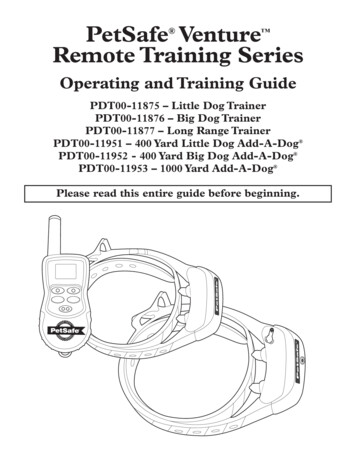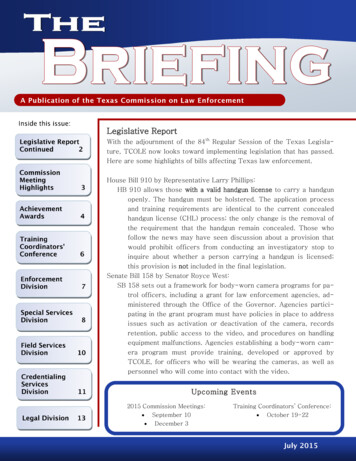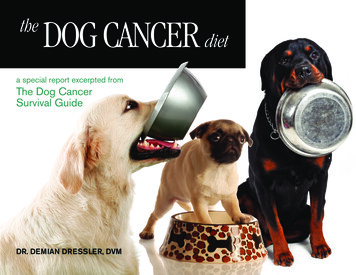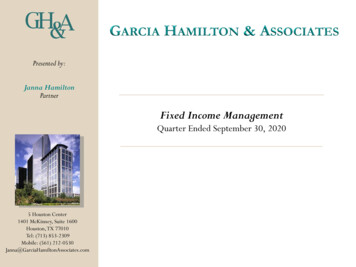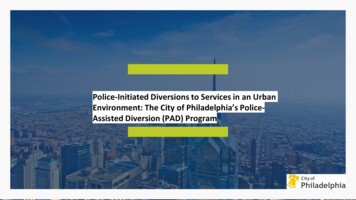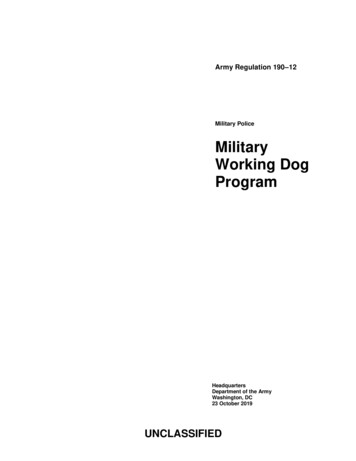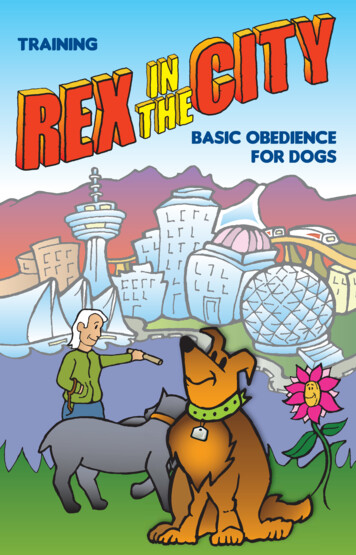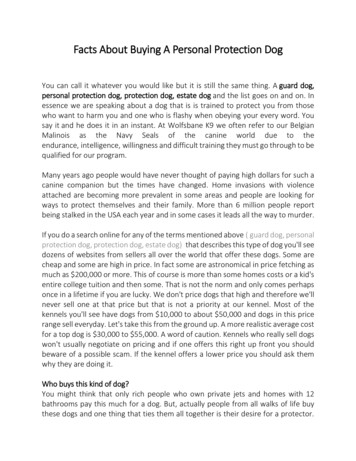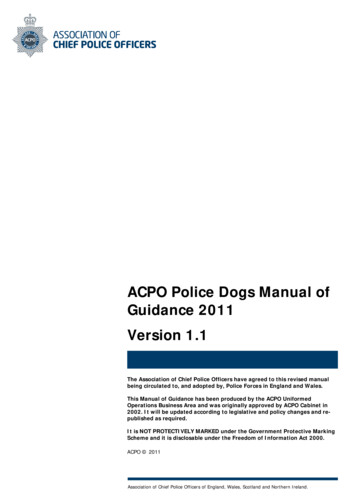
Transcription
ACPO Police Dogs Manual ofGuidance 2011Version 1.1The Association of Chief Police Officers have agreed to this revised manualbeing circulated to, and adopted by, Police Forces in England and Wales.This Manual of Guidance has been produced by the ACPO UniformedOperations Business Area and was originally approved by ACPO Cabinet in2002. It will be updated according to legislative and policy changes and republished as required.It is NOT PROTECTIVELY MARKED under the Government Protective MarkingScheme and it is disclosable under the Freedom of Information Act 2000.ACPO 2011Association of Chief Police Officers of England, Wales, Scotland and Northern Ireland.
2ACPO Police Dogs Manual of Guidance, Version 1.1 (March 2011)ContentsAuthorACC Nick IngramForce / OrganisationDyfed Powys PoliceDate CreatedMarch 2011Telephone01267 226 357Implementation Date2011Review Date2014SectionPage numberFOREWORDSECTION A – POLICIES & PROCEDURES1. Introduction2. National Police Dog Strategy 2011 - 20143. Legal Framework – Human Rights4. Conflict Management5. Operational Deployment Of Police Dogs6. Health and Safety7. Animal Welfare8. Course Aims and Objectives9. Menu Of Options10. Selection of Dog Handlers11. Quality Assurance Processes (Licensing)12. Good Practice Regarding Police Dog Bites13. Equipment14. Standard Operating Protocol (S.O.P) Guidance15. Good Practice for Police Dog Operations in Areas of Sensitivity16. ACPO Police Dog Instructors17. Course Aims and Objectives (Instructors)SECTION B – TRAINING & CARE1. General Principles of Police Dog Training2. Obedience and Agility3. Theory of Scent4. Tracking5. Searching6. Bite Work7. Victim Detection Dogs8. Forensic Evidence Search Dogs9. Firearms Support Dogs10. Passive Drugs Dogs11. Drugs Search Dogs12. Health of Dogs13. Dealing with Dangerous DogsSECTION C – NATIONAL POLICE DOG ASSESSMENT MODEL1. Introduction2. Guidance Notes to Assessors3. Tracking245404. Searching246415. Use of Force6. Obedience7. Licensing FormsSECTION D – TRIALS SCHEDULE8. Regional-National Police Dog Trials Schedule “Excellent” ModelSECTION E – EXPLOSIVE SEARCH DOG DETECTION TEAM (ESDDT)1. Training and ProceduresAssociation of Chief Police Officers of England, Wales, Scotland and Northern 82632632758276
3ACPO Police Dogs Manual of Guidance, Version 1.1 (March 2011)2. Operational Deployment3. Body Scanning Explosive Search Detection Dogs4. AppendiciesAppendix 1Prescribed Explosive Substances / Inferents andGroupingsAppendix 2Scent ID Procedure ProtocolAppendix 3Intelligence SourcesAppendix 4Search LevelsAppendix 5EquipmentAppendix 6StressAppendix 7Explosive Body Scanning Dogs- Guidance Notes onthe use of Volunteer Training AssistantsAppendix 8AbbreviationsSTANDARD NATIONAL DOCUMENTSAppendix 9Units of assessment - ESDDT Initial and RefresherAppendix 10Units of assessment Body Scanning ESDDT-Initialand RefresherAppendix 11Refresher Course Training-Needs AnalysisAppendix 12Continuation Training ReportsAppendix 13ADR Carriage of Explosives and Hide Details (Thisshould be printed two sided and filed for hiderecording purposes)INSTRUCTOR TRAINING(IN CONJUNCTION WITH SECTION C- GP TRAINING AND CARE)Appendix 14Aide Memoire Police Action at Bomb ScenesAppendix 15Explosive Instructor ModuleAppendix 16ESDDT Log BookAssociation of Chief Police Officers of England, Wales, Scotland and Northern Ireland299310314
4ACPO Police Dogs Manual of Guidance, Version 1.1 (March 2011)FOREWORDThis 2011 Manual of Guidance is provided by the ACPO Police Dog Working Groupthrough the ACPO Uniformed Operations Business Area. It provides up to date guidanceon the selection of handlers, the training, kennelling and welfare of police dogs, as well asthe equipment that is approved for use in both the training and operational environment. It isbased on guidance currently available from professionals within the Police Service, as well assupport and advice from partner agencies where appropriate. Not only will adherence tothe guidelines offer protection against litigation, scrutiny of welfare issues and evidentialchallenge, it will also demonstrate that the Police Service is committed to the ethical andeffective management, training and handling of Police Dogs.As the chair of the national working group I have been continually impressed by thecommitment, dedication and expertise of our colleagues that work within the Police Dogsenvironment. The purpose of this manual is to provide the appropriate level of guidanceand direction to managers and practitioners, so that we can all further professionalise thediscipline and provide an effective and efficient support function to the operational arena.Consequently, as new practices and tactics are developed, resultant changes to thisManual will determine that it remains a ‘living’ document to reflect current thinking. Thismanual brings together a number of elements of doctrine into one area and sees theexplosives detection manual sit within the wider document.My sincere thanks goes to all those who have contributed to the development of thismanual. As the chair of the group I am proud that the reputation of the United Kingdom’sPolice Dogs and Handlers is ranked amongst the best in the world. This is in no small part dueto the expertise acquired in the training and working of dogs over the last fifty years, and theknowledge gained and examples of Good Practice that have been identified, are now to befound within the content of this Manual.Adherence to its guidance by all those involved in Police Dog work, together with the ongoingpursuit of excellence, will ensure that the Police Service can remain confident that itsprovision of a Police Dog response to the public remains at the highest level.ACC N IngramACPO Police Dog Working GroupMarch 2011Association of Chief Police Officers of England, Wales, Scotland and Northern Ireland
5ACPO Police Dogs Manual of Guidance, Version 1.1 (March 2011)SECTION A – POLICIES & PROCEDURES1. Introduction1.1.This manual of guidance is a reference guide for good practice in relation to the use ofpolice dogs, as well as placing the Police Service’s use of dogs in the wider context ofgeneral policing activity. It is based on the knowledge that all police communities havediffering requirements and the training and deployment of police dogs should reflectthose needs. The manual should be read in conjunction with each Force’s own PoliceDogs Strategic Threat and Risk Assessment (STRA) as necessary. The manual is for doghandlers, trainers and those responsible for the management of Police Dog Units. Themanual has been divided into five areas;1.2.3.4.5.Policies and ProceduresTraining and CareNational Police Dog Assessment Model and National Units of AssessmentPolice Dog Trials ScheduleExplosive Search Dog Detection Team (ESDDT) Training and Operating manual.1.2.The manual is primarily aimed at those staff who will be involved in the procurement,management, command, training, welfare and deployment of police dogs. These willinclude police dog handlers, trainers, nominated officers, supervisors, and senior officerswith line management responsibilities.1.3.It identifies the legislation to be considered when deploying police dogs, the types ofspecialist skills available, as well as the considerations required when they are used. Italso considers the selection of dog handlers and the quality assurance process.1.4.It does not provide a directory of specific ‘approved’ training, nor does it remove theresponsibility of individual forces to identify specialist training needs based upon regularenvironmental scanning and associated threat and risk assessment.1.5.It recognises that it is the responsibility of the individual forces to ensure that their policedogs can be worked safely in the public arena.1.6.This manual should be read in conjunction with the following national doctrine relating toassociated areas:1. ACPO Public Order Manual of Guidance – “Keeping the Peace”.2. ACPO Manual of Guidance on the Management, Command and Deployment of ArmedOfficers.3. POLSA Manual.4. Police Search Team Course Book.5. Guidance on the Management and Investigations of Missing Persons.6. Relevant Home Office Circulars.7. National, regional and local policy documents.1.7.The Human Rights Act 1998, in particular Article 2 (right of life), Article 3 (prohibition oftorture or inhumane or degrading treatment) and Article 8 (right to respect for privateand family life-which includes physical and psychological integrity).Association of Chief Police Officers of England, Wales, Scotland and Northern Ireland
6ACPO Police Dogs Manual of Guidance, Version 1.1 (March 2011)2. National Police Dog Strategy 2011 – 20142.1.Police dogs provide essential support to front line officers and police staff in a variety ofroles including:1. Patrol activity as part of general policing2. Protection of the public, public reassurance, prevention and detection of crime3. In support of public order policing4. As a less than lethal option when supporting armed officers managing firearmsincidents5. Person and property search6. Specialist Search (explosives, drugs, cash and firearms)This support is critical to the continued effectiveness of policing within the UK.2.2.The Association of Chief Police Officers (ACPO) and Association of Chief Police Officers Scotland (ACPOS) Police Dogs Working Group (PDWG) is responsible for identifying andpromoting good practice and the setting of standards in relation to all these matters. Thepurpose of this document is to establish the Group’s aims, objectives and standardsrelevant to the management, command, training, welfare and deployment of police dogs.2.3.STRATEGIC AIMTo ensure that acquisition, training, deployment and management of dogs utilised forpolice work is subject to the highest professional standards and that the serviceconstantly strives to:1. Maintain and improve effective dog handling capabilities2. Develop and enhance operational disciplines and methodologies in a way that maintains public confidence, builds upon existing partnershiparrangements, and ensures at all times the welfare of all police dogs.2.4.The role of the PDWG to provide support and guidance to Police Dog Units by:1. Identifying and address emerging strategic issues2. Providing a central point of reference for issues of a national interest3. Reviewing and developing the associated manuals of guidance4. Working with Forces and key stakeholders to further develop guidance and goodpractice2.5.The PDWG will encourage individual Police Forces to support the management of PoliceDog Units, police dog training and operational deployment with clearly defined policiesand procedures in relation to;1.2.3.4.Management of the UnitStrategic Threat and Risk AssessmentAnimal WelfareManagement of Dangerous DogsAssociation of Chief Police Officers of England, Wales, Scotland and Northern Ireland
7ACPO Police Dogs Manual of Guidance, Version 1.1 (March 2011)3. Legal Framework – Human Rights3.1.THE PRINCIPLES OF HUMAN RIGHTSRespect for an individual’s human rights should be borne in mind throughout the entireprocess of policing. There is an obvious expectation that all policing will be conductedreasonably and within the bounds of the law.3.2.It is recognised within the European Convention on Human Rights that the responsibilitiesof the police extend not only to taking positive action to protect those rights andfreedoms but also includes a failure to act or to take steps to protect them.3.3.The Human Rights Act 1998 incorporated the ECHR Articles into UK domestic law. TheECHR Articles, contained in Schedule 1, Part 1, of the Human Rights Act 1998, providestatutory protection for certain human rights. Article 2 (right to life), Article 3 (prohibitionfrom torture, inhumane or degrading treatment, Article 5 (liberty and security of person),Article 8 (right to respect for private and family life), Article 10 (freedom of expression),Article 11 (freedom of assembly and association) and Article 14 (enjoyment of the ECHRrights and Freedoms without discrimination) are of particular relevance, though this is notan exhaustive list.3.4.All officers have an individual responsibility for ensuring that they are properly educatedand informed about the extent of their legal powers and the context within which thosepowers can properly be exercised. It is unacceptable for a police officer to claimignorance of the law.3.5.The decision making process of a police officer, regarding their use of police powers,should take account of the following considerations:1. Does my objective relate to a legitimate aim in terms of the ECHR Articles?2. Is what I am doing proportionate?3. Do I have a lawful power?4. Is there a legal basis to my action?5. Is the proposed action relevant and necessary?6. Is there a reasonable relationship between the aim to be achieved and the meansused?7. Is there a less intrusive alternative?8. Can the objective be achieved with less impact on the rights of the subject and anyother(s) likely to be affected by the action?9. Is there a record of my decision and rationale?3.6.A record should be kept of all decisions made and actions taken which may affectsomeone’s rights. The record should include the supporting rationale for the decisionmade/action taken.3.7.In deciding whether the action was ‘necessary in a democratic society’ it will be necessaryto show that:1. The action fulfilled a pressing social need, and2. The action pursued a legitimate aim, andAssociation of Chief Police Officers of England, Wales, Scotland and Northern Ireland
83.8.ACPO Police Dogs Manual of Guidance, Version 1.1 (March 2011)there was a reasonable relationship of proportionality between the means employed andthe aim pursued.This means that the action was designed to:1. Impair as little as possible the right or freedom in question2. Meet the objectives of the domestic law in question and3. Not be arbitrary, unfair or based on irrational considerations, and4. Be balanced against the severity of the effect that the measure has on the individual orgroup. The more severe the adverse effects of the measure, the more important theobject must be if it is to be classified as legitimate.3.9.RESPECT FOR RACE AND DIVERSITYIn addition to the requirements of the European Convention on Human Rights/HumanRights Act (ECHR/HRA), public authorities, in carrying out their functions must notdiscriminate, harass or victimise on grounds of:1.2.3.4.5.6.Race (Section 19B, Race Relations Act 1976 as amended)Disability (Section 2, Disability Discrimination Act 2005)Religion or belief (Section 52, Equality Act 2006)Gender (Section 83, Equality Act 2006)Sexual orientation (Reg 8 Equality Act (Sexual Orientation) Regulations 2007)Age (The Employment Equality Age) Regs 20063.10.The law and regulations regarding use of force is contained within:3.11.COMMON LAWIf you have an honestly held belief that you or another are in imminent danger, then youmay use such force that is reasonable and necessary to avert that danger.3.12.SECTION 117 PACE ACT 1984Where any provision of this Act or order:1. Confers a power on a constable; and2. Does not provide that the power may only be exercised with the consent of someperson, other than a police officer the officer may use reasonable force, if necessary, in the exercise of the power.3.13.POLICE REGULATIONS RELEVANT TO THE USE OF FORCEThe Standards of Professional Behaviour as set out in the Police (Conduct) Regulations2008 address the use of force and abuse of authority, including:1. Honesty and Integrity: Police officers are honest, act with integrity and do notcompromise or abuse their position.2. Authority, Respect and Courtesy: Police officers act with self control and tolerance,treating members of the public and colleagues with respect and courtesy.3. Use of Force: Police officers only use force to the extent that is necessary,proportionate and reasonable in all the circumstances.3.14.SECTION 3 CRIMINAL LAW ACT 1967 AND SECTION 3 CRIMINAL LAW ACT(NORTHERN IRELAND) 1967Association of Chief Police Officers of England, Wales, Scotland and Northern Ireland
9ACPO Police Dogs Manual of Guidance, Version 1.1 (March 2011)A person may use such force as is reasonable in the circumstances in the prevention ofcrime, or in effecting or assisting in the lawful arrest of offenders or suspected offendersor of persons unlawfully at large.4. Conflict Management4.1.The ACPO Personal Safety Manual of Guidance will guide practitioners in dealing generallywith conflict.4.2.This manual is for those incidents where there is the potential to use police dogs toresolve conflict. The police use of dogs will however, almost always be only a componentpart of conflict resolution, not the entire resolution. It must be considered in the widerperspective of police command and control.4.3.Police officers have a positive duty to act to protect the public from danger. While it isdesirable to completely remove any danger identified, it is more likely that the policeresponse will reduce that danger. In doing so it may be necessary for police staff toassume some risk of harm in order to achieve public protection. In resolving conflict, thebalance of risk to all those potentially affected must be carefully considered, and controlmeasures applied proportionately.4.4.Therefore, when making decisions about public protection, the Conflict ManagementModel, consistent within other police guidance manuals, is recommended to provide aconsistent and auditable process that ensures prioritisation of actions that seek to achievethat aim.4.5.THE CONFLICT MANAGEMENT MODELIn any conflict situation, or anticipation of a conflict, a decision-making process isnecessary to ensure that the conflict is dealt with in a logical and progressive manner.The Conflict Management Model (CMM) illustrates an approach by Police Servicepersonnel to the resolution of conflict. In a logical progression it shows a process ofgathering information, assessment and consideration prior to an action taking place. Itmay be unexpressed, being unconsciously worked and reviewed in a face to faceconfrontation or be an explicit cycle in decision making, decision rationale being recordedagainst each element.It can be applied to spontaneous incidents or pre-planned operations, an individual onpatrol or teams of officers dealing with an incident involving firearms or large-scaledisorder. All stages of the model should not be seen as the sole responsibility of rs&PoliciesAssociation of Chief Police Officers of England, Wales, Scotland and Northern IrelandTacticalOptions
10ACPO Police Dogs Manual of Guidance, Version 1.1 (March 2011)4.6.When facing or anticipating a threat, information and intelligence received leads to athreat assessment as to the dangers faced against whom and when. That informs anintention or working strategy which is likely to have an order of priority. Afterconsideration of the relevant and necessary powers and policy the appropriate tacticaloptions are chosen to manage the threat and resolve the conflict by proportionate action.4.7.As the situation develops or actions affect the circumstances, so it provides momentumto a cyclic review of all the elements in turn. This may occur in a situation that lasts asplit second but also provides a sound basis for planning that may develop over a muchlonger term.4.8.INFORMATION AND INTELLIGENCE RECEIVEDThe acquisition of knowledge of the situation is essential in determining the mostappropriate response to mitigate danger. Information and intelligence are an importantelement of overall knowledge of the situation.The following questions should be considered in pursuit of knowledge:1. What is fact and what is assumption?2. What is known now?3. What could be known?4. What should be known?That knowledge could include:1. Intelligence available about the subject, their identity, capability and intent2. Current description (including a photograph if possible)3. Nationality and languages spoken4. Other factors affecting communication with the subject (whether deaf, hard of hearingor speech difficulties)5. Previous convictions (and of what is the subject currently suspected).6. The influence or immediate availability of alcohol/drugs7. Subject’s knowledge of the location8. Intelligence available about the subject’s associates or the area where the incidenttakes place9. The nature of any weapons involved and the level of experience the subject has withfirearms (legal or illegal)10. Any medical history of the subject which may require special consideration11. Any danger the subject poses to others, either now or in the future12. The presence of other parties - their number, identities, ages, descriptions andlocations13. In appropriate cases efforts must be made to confirm the presence and location ofany hostages. For example, if possible, it should be determined whether they are tied upor secured to heavy furniture or fittings14. Any community impact factors associated with the location. (In all operations a formalCommunity Impact Assessment should be carried out if practicable)15. Any hazards / risks associated with the location4.9.THREAT ASSESSMENTThis is the process of determining the likelihood and extent of harm being caused throughthe actions of any person. It requires the continuing evaluation of the situation, and istime critical. It is necessarily a judgemental process, informed by fact, intelligence andexperience. Threat assessment forms the basis on which the proportionality of the policeresponse will be judged.Association of Chief Police Officers of England, Wales, Scotland and Northern Ireland
11ACPO Police Dogs Manual of Guidance, Version 1.1 (March 2011)The threat when assessed can then be compared against the extent of vulnerabilityassessed, and this will provide the overall risk assessmentIn simple terms:Threat Likelihood X consequenceVulnerability Control measures X predictabilityRisk Threat X vulnerability4.10.Knowledge of the situation will directly influence the police intention or strategy toprotect the public. Information that has not been assessed is, however, of little value inthis respect since it does not contain any evaluation. Only when the knowledge of thesituation has been assessed can a credible police intention be set. Within the principles ofconflict management therefore the earliest stage at which the overall police strategyshould be determined is on completion of a threat assessment. This may be quicklycompleted and based on minimum information. It can, however, be refined and updatedas the threat assessment becomes more robust.4.11.The strategy for the police operation must be to have priorities, reflecting the reality thatachieving all policing aims to the same extent at the same time is desirable but unlikely.Therefore, at the time the strategy is created it must reflect the priority objective first.Since the information and intelligence will change, as will the threat assessment, thestrategy must, therefore remain dynamic and capable of review within the CMM.4.12.POWERS AND POLICIESThese will be used appropriately and lawfully in compliance with legislation, as well asnational, regional and local policies and guidance.4.12.1. Considerations should include:1. Are officers empowered under statute or common law to undertake aparticular task2. Is there a power of search / arrest available3. Are there any ACPO or force policies, guidance or instructions relating to theproposed course of action4.12.2. Action(s) taken must be:1. ECHR compliant2. Regularly reviewed3. Auditable4.13. TACTICAL OPTIONSAppropriate options should be considered for resolving the situation being faced. Theyshould be wide ranging and carry advantages and disadvantages to each option. Whereappropriate and available, tactical advice should be sought from specialists in this field.4.14.ACTIONS AND CONTINGENCIESOnce all available options have been considered, a preferred option should then bedeveloped and progressed with appropriate contingencies in place to meet anyreasonable eventualities.Use of the CMM should be made in evidencing suitable justification for the deployment ofa police dog.Association of Chief Police Officers of England, Wales, Scotland and Northern Ireland
12ACPO Police Dogs Manual of Guidance, Version 1.1 (March 2011)5. Operational Deployment of Police Dogs5.1.INTRODUCTIONAll police dog handlers will need to justify the direct deployment of their police dog bymaking reference to the Conflict Management Model.5.2.As with all use of force applications it will be for an individual officer to justify theiractions based on their perception at an incident with regard to their training and previousexperience. It is impossible to dictate to an individual officer when they should, or shouldnot, utilise force to affect control. For this reason there is not a list of ‘appropriateoffences’ for when a police dog might be deployed or not; the test is rather one ofnecessity and proportionality in those particular set of circumstances.5.3.USE OF POLICE DOGS – DEPLOYMENT CATEGORIESIt is necessary to distinguish those police dog deployments that are not considered to bea direct use of force. Whilst it is recognised that a police dog is an animal that has its owndecision making process (especially when under stress), they are, nonetheless subject torigorous continual training and assessment making them safe and efficient to work in alloperational circumstances.5.4Non “use of force” deployments may include:1. Searching for suspects or vulnerable persons2. Searching for articles of evidential value3. Specialist searches (Drugs/Explosives/Firearms/Cadaver)4. Crime scene5. Tracking of suspects from crime scenes (as distinct from direct deployment toapprehend an offender in flight)6. Community engagement5.5“Use of force” deployments include:1.2.3.4.5.6.7.8.9.5.6.Pursuing and detaining a suspect who is making offEngaging and detaining a suspect who presents a threatGuarding and escorting suspects after apprehensionDefending handler against attackDefending other officers against attackProtecting members of the publicProtecting propertyDefending itself against attackCrowd controlPublic DisorderThe methods of deploying police dogs within a public order context is set out the relevantACPO Public Order ManualThe Police response to public disorder is:5.6.1. Indirect - Where the dog and handler are deployed at the periphery of an incident,with the dog in the police vehicle, providing a visible deterrent and with thehandler observing the incident developing.Association of Chief Police Officers of England, Wales, Scotland and Northern Ireland
13ACPO Police Dogs Manual of Guidance, Version 1.1 (March 2011)5.6.2. Interim Deployment - Where the dog and handler are deployed from the vehicle,on foot, remaining at a (safe) distance. The handler can then deploy in line withthe conflict management model.5.6.3. Direct Deployment – These are circumstances where the dog is deployed and islikely to, or instructed to, bite a subject. At this point a verbal warning should begiven by the handler if circumstances allow.5.7.Post Deployment ProceduresProtocols relating to the ‘use of force’ and reporting injuries or damage caused by policedogs should be well established within individual forces. Dog handlers must be well awareof their own force’s reporting procedures and comply with them.5.8.Police dogs can cause serious injury and officers must be aware of the duty of care thatthey have to any person to whom their dog has caused injury. The onset of shock can beswift after a dog bite and handlers and escorting officers should be aware of thesymptoms of it.5.9.Where the incident involved injury to a subject who is arrested the following actions willbe taken:1. On arrival at the custody suite the handler or escorting officers will make the custodyofficer aware that the subject has injuries caused by the deployment of a police dog2. The custody officer will record the injuries and arrange for medical examination andtreatment where necessary3. If a subject wishes to make a formal complaint the custody officer should make thenecessary arrangements4. The dog handler will make their line manager and nominated officer aware of theincident and submit the necessary report in line with force procedure6. Health and Safety6.1.INTRODUCTIONThe Police (Health & Safety) Act 1997 extended the Health and Safety at Work Act 1974to cover police officers.6.2.Health & Safety requirements are intended for the workplace, however police doghandlers are charged with the 24 hour responsibility for the care and exercise of theirpolice dog at their home address. It should therefore be considered as ‘good practice’ toextend these requirements to include the handler’s home environment into which thepolice dog is to be accommodated. The area to which the kennel is placed should also beconsidered as the workplace for the purpose of Health and Safety Management.6.3.Responsibilities under Health and Safety legislation fall upon the ACPO ranks but the dayto day responsibilities lie with the practitioners in the form of Nominated Officers,Instructors, Environmental Training Officers and of course Dog Handlers.6.4.It is strongly recommended that consideration be given to police dog instructors beingtrained as Health & Safety Risk Assessors due to the potentially hazardous nature of thework they undertake and supervise.It has been long understood that police dog training involves the use of a wide variety offacilities and venues. The proportionality of regularly risk assessing all venues to a6.5.Association of Chief Police Officers of England, Wales, Scotland and Northern Ireland
14ACPO Police Dogs Manual of Guidance, Vers
5. Explosive Search Dog Detection Team (ESDDT) Training and Operating manual. 1.2. The manual is primarily aimed at those staff who will be involved in the procurement, management, command, training, welfare and deployment of police dogs. These will include police dog handlers, train
